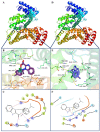Synthesis, Characterization and Biological Investigations of Half-Sandwich Ruthenium(II) Complexes Containing Benzimidazole Moiety
- PMID: 36615237
- PMCID: PMC9821818
- DOI: 10.3390/molecules28010040
Synthesis, Characterization and Biological Investigations of Half-Sandwich Ruthenium(II) Complexes Containing Benzimidazole Moiety
Abstract
Half-sandwich Ru(II) complexes belong to group of biologically active metallo-compounds with promising antimicrobial and anticancer activity. Herein, we report the synthesis and characterization of arene ruthenium complexes containing benzimidazole moiety, namely, [(η6-p-cymene)RuCl(bimCOO)] (1) and [(η6-p-cymene)RuCl2(bim)] (2) (where bimCOO = benzimidazole-2-carboxylate and bim = 1-H-benzimidazole). The compounds were characterized by 1H NMR, 13C NMR, IR, UV-vis and CV. Molecular structures of the complexes were determined by SC-XRD analysis, and the results indicated the presence of a pseudo-tetrahedral (piano stool) geometry. Interactions in the crystals of the Ru complexes using the Hirshfeld surface analysis were also examined. In addition, the biological studies of the complexes, such as antimicrobial assays (against planktonic and adherent microbes), cytotoxicity and lipophilicity, were performed. Antibacterial activity of the complexes was evaluated against S. aureus, E. coli, P. aeruginosa PAO1 and LES B58. Cytotoxic activity was tested against primary human fibroblasts and adenocarcinoma human alveolar basal epithelial cells. Obtained biological results show that the ruthenium compounds have bacteriostatic activity toward Pseudomonas aeruginosa PAO1 strain and are not toxic to normal cells. A molecular docking study was applied as a predictive source of information about the plausibility of examined structures binding with HSA as a transporting system.
Keywords: X-ray diffraction; antibacterial and antibiofilm activity; electrochemistry; molecular docking studies; ruthenium complexes; structural and spectroscopic studies.
Conflict of interest statement
The authors declare no conflict of interest. The funders had no role in the design of the study; in the collection, analyses, or interpretation of data; in the writing of the manuscript, or in the decision to publish the results.
Figures










Similar articles
-
Ruthenium Complexes with 2-Pyridin-2-yl-1H-benzimidazole as Potential Antimicrobial Agents: Correlation between Chemical Properties and Anti-Biofilm Effects.Int J Mol Sci. 2021 Sep 18;22(18):10113. doi: 10.3390/ijms221810113. Int J Mol Sci. 2021. PMID: 34576276 Free PMC article.
-
Half-sandwich Ru(η6-p-cymene) complexes featuring pyrazole appended ligands: Synthesis, DNA binding and in vitro cytotoxicity.J Inorg Biochem. 2019 May;194:74-84. doi: 10.1016/j.jinorgbio.2019.02.012. Epub 2019 Feb 23. J Inorg Biochem. 2019. PMID: 30831392
-
Synthesis, Structural Characterization and Antimicrobial Evaluation of Ruthenium Complexes with Heteroaromatic Carboxylic Acids.Chem Biodivers. 2019 Nov;16(11):e1900403. doi: 10.1002/cbdv.201900403. Epub 2019 Oct 30. Chem Biodivers. 2019. PMID: 31515947
-
Similarities and differences in d6 low-spin ruthenium, rhodium and iridium half-sandwich complexes: synthesis, structure, cytotoxicity and interaction with biological targets.J Biol Inorg Chem. 2019 Jun;24(4):591-606. doi: 10.1007/s00775-019-01665-2. Epub 2019 May 21. J Biol Inorg Chem. 2019. PMID: 31115765 Free PMC article.
-
Synthesis, characterization, antimicrobial and cytotoxic activity of novel half-sandwich Ru(II) arene complexes with benzoylthiourea derivatives.J Inorg Biochem. 2020 Sep;210:111164. doi: 10.1016/j.jinorgbio.2020.111164. Epub 2020 Jun 26. J Inorg Biochem. 2020. PMID: 32634653
Cited by
-
Ruthenium Complexes with Pyridazine Carboxylic Acid: Synthesis, Characterization, and Anti-Biofilm Activity.Molecules. 2024 Dec 2;29(23):5694. doi: 10.3390/molecules29235694. Molecules. 2024. PMID: 39683853 Free PMC article.
References
-
- Warra A.A. Transition metal complexes and their application in drugs and cosmetics—A Review. J. Chem. Pharm. Res. 2011;3:951–958.
MeSH terms
Substances
Grants and funding
LinkOut - more resources
Full Text Sources
Molecular Biology Databases

